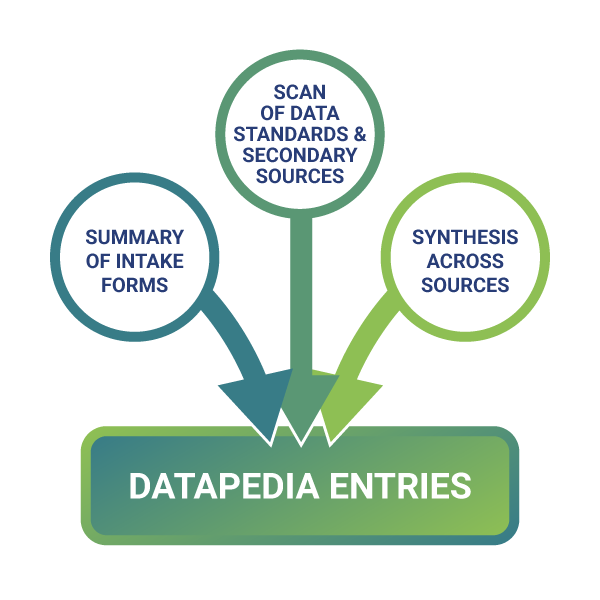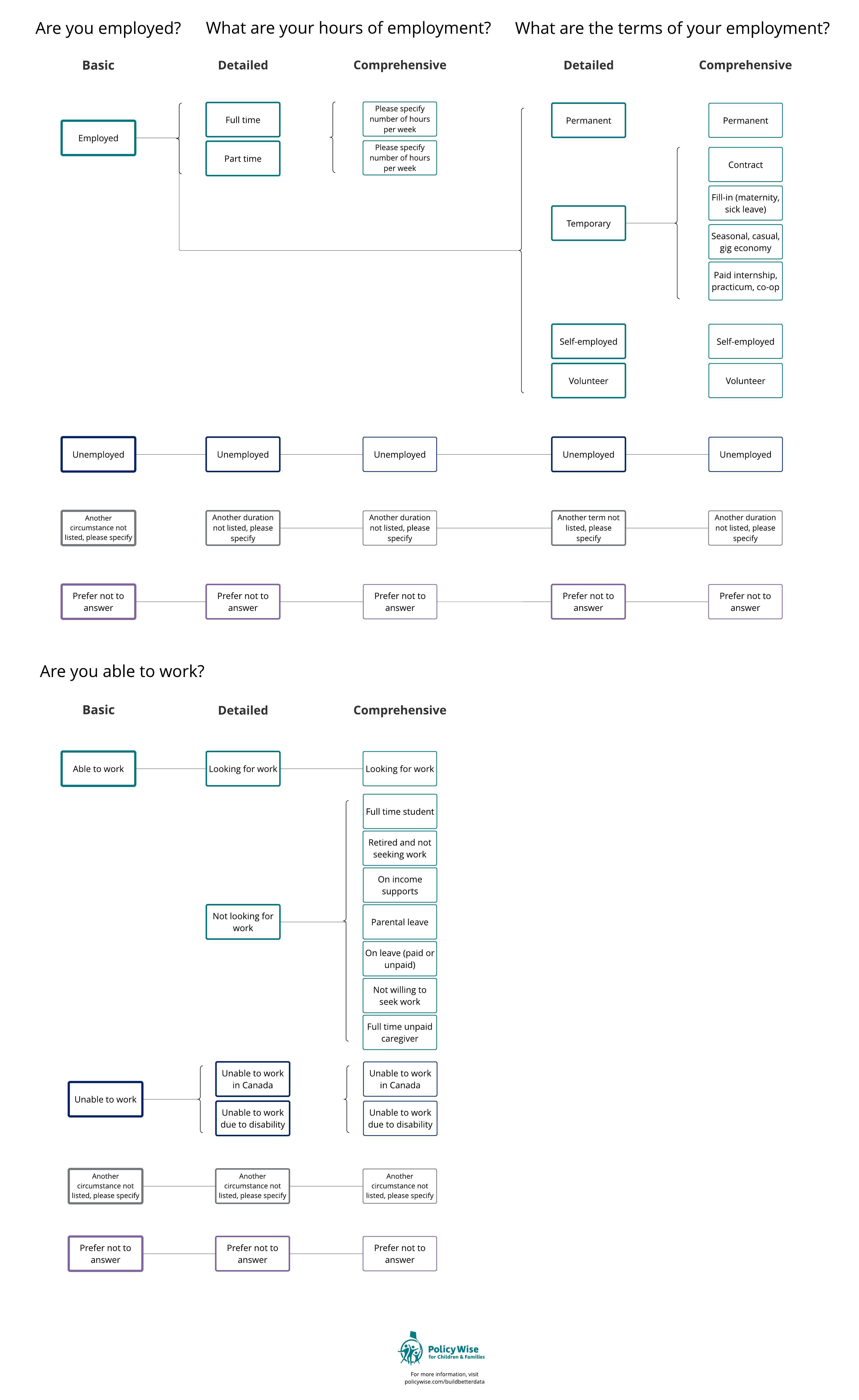Demographic Datapedia Entry:
Employment
Each Datapedia entry begins with definition(s) of the demographic variable followed by some considerations and limitations of the variable for understanding populations of people.
Next, a suggested question(s) and response options are shown. Note that this is given as guidance rather than a prescription of what’s best as that will depend on the information needs and context of your organization. Also included are ideas and examples of how to ask questions about the demographic variable in conversation.

Plan
It’s important to invest time in seeking out your “Why?” with data to ensure the data collected support your information needs. For more on this, see the Plan section of the Data Lifecycle.
Finally, a diagram is shown to illustrate basic, detailed, and comprehensive response options for the variable.
- The basic options are the minimum set of response options that are suggested for each variable.
- The detailed and comprehensive categories illustrate more detailed and nuanced response options that may be important to consider depending on your information needs and organization’s context.
- The diagram of response options show how each category can be collapsed into the basic set of answers. For example, the detailed and comprehensive response options can be collapsed or aggregated into the basic response options for analysis.
- Consider all response options when deciding on which category best suits your organization’s needs.
Importantly, the suggestions and details of the response options will need to be revisited and revised periodically to reflect shifts and changes that may emerge in various variables over time.1

BUILD
For ideas on how to collect and record quality data see the Build section of the Data Lifecycle.
2.1 Definition
A. Employment refers to individuals who have done any paid work at a job or business either as an employee or under self-employment (Statistics Canada). The employed may also be temporarily absent from work due to illness, strikes, vacation, etc. (Statistics Canada).2 Those who are unemployed may not be looking for work because they are unable to work, or because they are not looking for work (e.g., retired or on leave).
B. Employment categories include full-time, part-time, unemployed, on leave, and permanent/temporary/contract.3
2.2 Considerations and Limitations
Employment can be useful to understand:
- Whether a person has a source of income.
- In aggregate, knowing about employment of clients can demonstrate community needs in the services organizations provide.
- Trends in sectors to understand economic ebbs and flows.4
- Populations that may or may not be eligible for government supports.5
- Unemployment rates of industries.6
- Quality of work available to employees.
Employment cannot be used to understand:
- Whether the amount of work is sustainable, stable, and sufficient to meet basic financial needs.7
- Details about household income as that can be important for example, for determining eligibility for programs for children and youth, or when an agency needs to consider household income and number of people in household, e.g., when calculating low-income cut-offs.8
- A person’s work history, education attained, or employment goals.
- Soft skills not gained from work experiences.9
- Additional skills or training needed.
Additional Considerations:
- Whether to ask at all? Is it relevant to the supports that agencies are providing to clients?
- People may be unable to work for various reasons such as being a full-time student or full-time unpaid caregiver, or having a disability, being on leave (e.g., for medical reasons), or they are unable to work in Canada.
- People may not be looking for work because they are retired (over 65 years) and not willing to seek work, they may not be retired and are aren’t willing to seek work (65 and under), or individuals may be on income supports (AISH, disability insurance, etc.), or be on parental leave.
- Language barriers and cultural considerations may impact employment options.10, 11
2.3 Suggested Collection Methods
The minimum suggested data collection method, or “basic” option reflects a synthesis of practices, considerations from nonprofit stakeholders, and recognized standards in capturing demographic data. The suggested method is modeled after what might be asked on an intake form during an initial meeting with a client. The process by which intake or registration occurs can vary widely depending on the context within which you are working. For example, the way questions are asked and data are recorded will vary for clients in crises, as compared to walk-in or drop-in sessions, or when registering for a program that requires people to meet certain eligibility requirements. In those cases, the suggested collection method can be used as a starting point but adapted to fit the needs of the context within which the data are being collected.
As a standard practice we suggest always including an option for people to write in an answer that may not fit within the options provided, along with an option not to answer. These are both important for creating inclusive demographic questions.1, 12, 13
2.3.1 Basic Question(s)
1. Are you employed?
- Employed
- Unemployed
- Prefer not to answer
2. What are your hours of employment?
- Full time
- Part time
- Another duration not listed, please specify: _____
- Prefer not to answer
3. What are the terms of your employment?
- Permanent
- Temporary
- Self-employed
- Volunteer
- Another duration not listed, please specify: _____
- Prefer not to answer
4. Are you able to work
- Able to work
- Unable to work
- Prefer not to answer
In conversation, the question may be phrased as:
- Tell me about your career goals.
- What is your employment history?
- Where was your last job?
- When was the last time you were employed?
- How often are you working?
- Do you have any labour/journeyman tickets or certificates?
- Are you seeking employment?
- How long were you at your last place of employment?
- If currently employed, is it secure, full or part time?
- Are you happy with your current place of employment?
2.3.2 Diagram of Response Options
The diagram shows an overview of the basic, detailed and comprehensive response options. The options are not necessarily exhaustive, but they are modeled after what organizations may want to provide depending on the needs and context of their work. The question can be found at the top of the diagram and the response choices are mapped into the basic, detailed, and comprehensive levels. Not all variables warrant all levels of response options.

COLLECT
For considerations on building trust and relationships through data collection see the Collect section of the Data Lifecycle.


LENSES
You may wish to approach your data collection work through the lens of a particular framework or set of guiding principles, which will shape how you think about your response options. For more details, see the Lenses section of the Data Lifecycle.
To create the diagram for variable responses, two main sets of sources were used.
- Organization intake and registration forms from nonprofit subsectors across Alberta.
- Best practices in data collection, academic literature of demographic data, and resources from data aggregators (e.g., Statistics Canada, National Institutes of Health).
Findings from these sources were synthesized and organized across three levels of response options: basic, detailed, and comprehensive. To learn more please see the full methods. Datapedia Project Approach and Acknowledgements.pdf
Footnotes
-
Frederick, J. K. (2020, November 18). Four strategies for crafting inclusive and effective demographic questions. Ithaka S+R Blog. https://sr.ithaka.org/blog/four-strategies-for-crafting-inclusive-and-effective-demographic-questions/
-
Yarhi, E. (2009, February 22). Unemployment in Canada. The Canadian Encyclopedia. www.thecanadianencyclopedia.ca/en/article/unemployment#:~:text=Employment%20and%20Unemployment,-Statistics%20Canada%20defines&text=Employed%20persons%20are%20defined%20by,employee%20or%20under%20self%2Demployment.
-
Statistics Canada. (2020, April 9). Guide to the labour force survey. www150.statcan.gc.ca/n1/pub/71-543-g/71-543-g2020001-eng.htm
-
Government of Canada. (2020, November 17). Canadian industry statistics. https://www.ic.gc.ca/app/scr/app/cis/search-recherche?lang=eng
-
Government of Canada. (2020, November 6). Benefits. https://www.canada.ca/en/services/benefits.html
-
Statista. (2021). Rate of unemployment in Canada in 2020, by industry. https://www.statista.com/statistics/578391/unemployment-rate-by-industry-canada/
-
Statistics Canada. (2020, September 8). Dimensions of poverty hub. www.statcan.gc.ca/eng/topics-start/poverty.
-
Chen, W.H. & Mehdi, T. (2018, December 10). Assessing job quality in Canada: A multidimensional approach. https://www150.statcan.gc.ca/n1/pub/75f0002m/2012002/lico-sfr-eng.htm
-
Australian Radiation Protection and Nuclear Safety Agency. (n.d.). Non-technical skills. Australian Government. https://www.arpansa.gov.au/regulation-and-licensing/safety-security-transport/holistic-safety/non-technical-skills
-
Lekic, A. (2016). Exploring the options to limit the English language barriers faced by newcomers to Canada, living in Toronto, in order to find meaningful employment. Athabasca University. http://dtpr.lib.athabascau.ca/action/download.php?filename=mais/700/Andrea%20Lekic%20MAIS%20700%20Final%20Paper%20for%20Athabasca%20University.pdf
-
Ng, E. & Gagnon, S. (2020, January 24). More research needed to break down job barriers for racialized Canadians. Policy Options. policyoptions.irpp.org/magazines/january-2020/more-research-needed-to-break-down-job-barriers-for-racialized-canadians/.
-
Fernandez, T., Godwin, A., Doyle, J., Verdin, D., Boone, H., Kirn, A., Benson, L., & Potvin, G., (2016). More Comprehensive and Inclusive Approaches to Demographic Data Collection. School of Engineering Education Graduate Student Series, 60. http://docs.lib.purdue.edu/enegs/60
-
Lesbian, Gay, Bisexual, & Transgender Equity Center. (n. d.). Good practices: Demographic data collection. University of Maryland. https://lgbt.umd.edu/good-practices-demographic-data-collection
Do you have additions to suggest to the Datapedia? Or, do you want to learn more about working with data?
We’d love to hear from you. Contact us at info@policywise.nickpetlock.com.


